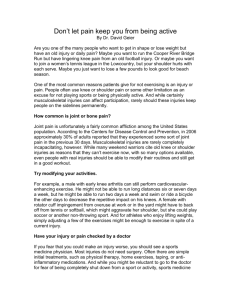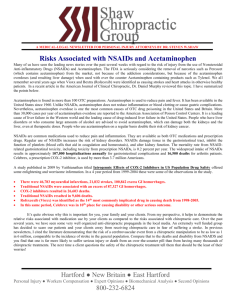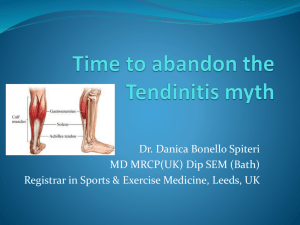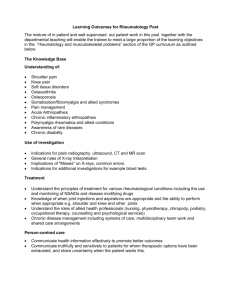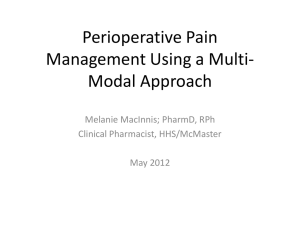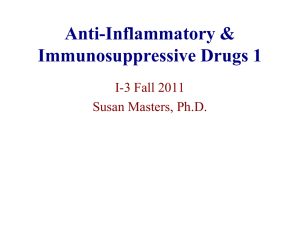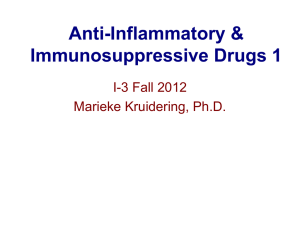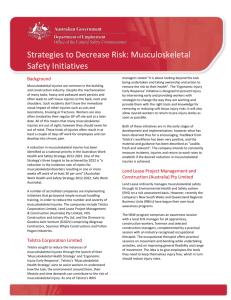Common Injuries to the knee, leg, ankle
advertisement
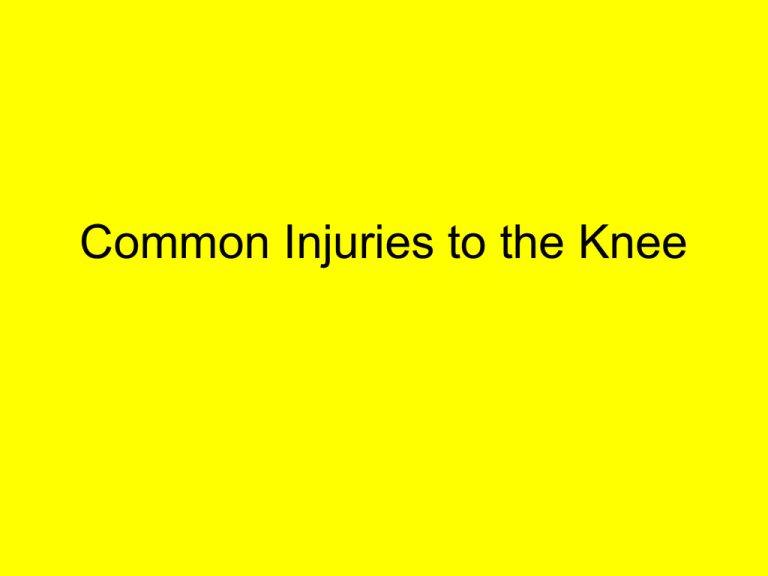
Common Injuries to the Knee ANTERIOR CRUCIATE INJURIES ACL injuries also commonly occur with hyperextension of the knee, deceleration and valgus stress. INDICATIONS FOR SURGERY: Complete tear; associated meniscal pathology Well motivated person who will do the rehab program; physiologically young Unwilling to change lifestyle; job and sports require twisting, cutting Minimal evidence of DJD WHEN TO DO SURGERY : Wait at least 3-4 weeks after injury •Decrease the swelling •Decrease Quad inhibition •Decrease hamstring overfiring •Decrease scarring •Increase ROM; decrease stiffness SURGERIES PERFORMED 1. Bone-tendon-bone with middle 1/3 of patellar tendon 2. Semitendinosis and gracilis: fold them in ½ so have a 4 tendon bundle 3. Allograph: bone-tendon-bone patellar tendon from cadaver Key in surgery is correct isometric placement of the graph. 80-90% of patients have a good result with surgery going back to previous levels of activity. Some complications that may arise and give a less than favorable result are: • Patellar tendonitis • Patellofemoral pain/chondromalacia • Limited ROM at extremes; loss of even a few degrees of terminal extension is a problem • Stretching out of graph COLLATERAL LIGAMENT INJURIES MCL tears: most common mechanism is a blow to the outside of the knee followed by planting of the foot and twisting of the knee. There is a high risk of injury to the medial meniscus with MCL tears. KNEE REHAB PATELLOFEMORAL PAIN SYNDROME The patella must have balanced muscular forces around it to ride properly in the femoral groove. The VMO should fire before the VL. The VMO/VL ratio should be 1:1 Tight ITB, hamstrings and calf can disrupt muscular balance. OTHER FACTORS CAUSING PFPS: 1. Overpronation 2. Anteversion 3. Weak Hip ER & ABD 4. Tibial Varum 5. Increased Q angle ILIOTIBIAL BAND SYNDROME Complains of pain on knee flexion May complain of snapping Pain gets worse on ROM from full flexion to full extension. Often result of: genu varum; over pronation; femoral anteversion; spinal problems. SHIN SPLINTS Most common area affected is antereomedial shin. Starts out as muscle/tendon injury Can progress to periosteal injury Can end up as a stress fracture ANKLE SPRAINS Ottawa ankle rules JOBST INTERMITTENT COMPRESSION DEVICE ROM exercises Strengthening Proprioception Agility Running/jumping Syndesmotic Injury ACHILLES TENDONITIS ACHILLES TENDON RUPTURE LONG REHAB: Average 6-9 months PLANTAR FASCITIS Over pronation Pes cavus foot Tight calf muscles Tibial varum Anteversion Weak ER of hip Pharmacology DRUGS USED FOR MUSCULOSKELETAL PATHOLOGY • Analgesics • Drugs that directly affect the healing process • Drugs that do both NON STEROIDAL ANTIINFLAMMATORY DRUGS (NSAIDS) • Treatment of inflammatory arthritic diseases • Treatment of the “itises” NSAIDS: SIDE EFFECTS • Gastrointestinal Irritation and Ulceration • Decreased Blood Clotting • Kidney Trouble • Other Common NSAIDs (OTC) Bayer (aspirin) Tylenol (acetaminophen) Aleve or Naprosyn (naproxen) Advil (ibuprofen) Common NSAIDS (Rx) • • • • • • Celebrex (celecoxib) Voltaren (diclofenac) Lodine (etodolac) Nalfon (fenoprofen) Indocin (indomethacin) Orudis, Oruvail (ketoprofen) • Toradol (ketoralac) • Daypro (oxaprozin) • Relafen (nabumetone) • Clinoril (sulindac) • Tolectin (tolmetin) • Vioxx (rofecoxib Dosing Depends Avoid Trial negative drug reactions and Error Every Must on Goal patient has a different response keep blood levels constant for antiinflammatory response CORTICOSTEROIDS • • • • • Synthetic derivative of cortisol Mobilizes energy stores Circulatory changes Changes in liver and kidney function Subdue inflammation and immune response ACTION • Stabilizes cell membranes which decreases release of inflammatory mediators • Inhibits migration of inflammatory cells that are attracted to the injured area. INDICATIONS • INFLAMMATORY DISEASES: RA, Lupus, Ankylosing Spondylitis • NO! Acute musculoskeletal injuries • ???? Chronic musculoskeletal injuries ADMINISTRATION • ORAL: Used in tx of diseases which affect multiple joints; Dose pack for chronic musculoskeletal problems • LOCAL INJECTION: Used for tendinitis, bursitis, fasciitis • TOPICAL USE: Dermatologic effects only SIDE EFFECTS: ORAL • Osteoporosis: pathologic fractures • Avascular Necrosis • Disturb fat and carbo metabolism: increase risk of diabetes; increased fat distribution in trunk and face • Hypertension due to NA and H20 retention • Steroid myopathy • Steroid psychosis SIDE EFFECTS: LOCAL INJECTION • No systemic effects • False sense of recovery • Local tendon/muscle atrophy: rupture • Skin changes ANALGESICS • Allow early initiation of rehab • Improve quality of life for persons with chronic pain • Allow patients to tolerate surgery NON-NARCOTIC • Acetaminophen: Has central nervous system effect through cental inhibition of prostaglandins • Aspirin: Has peripheral effect through peripheral inhibition of prostaglandins • NSAIDS: Have analgesic effect on nervous system as well as decreased inflammation NARCOTIC • Common property: bind to opioid receptors in brain • Results in significant elevation of pain threshold; can be addictive INDICATIONS • Mild/moderate musculoskeletal pain: nonnarcotics; acetaminophen first choice; NSAIDS may be more logical if inflammation is causing pain, ie acute injuries and inflammatory arthritis • Osteoarthritis: acetaminophen • Chronic musculoskeletal pain: acetaminophen Continued…… • Acute postoperative pain: narcotics; can be given IV or IM • Chronic, Severe pain: narcotics See Table 3 for commonly used analgesic drugs SIDE EFFECTS • ACETAMINOPHEN: generally safe; liver toxicity • ASPIRIN/NSAIDS: as previously covered • NARCOTICS: respiratory suppression; sedation, nausea and vomiting; urinary retention; euphoria/dependence ANTIBIOTICS • Used to treat or prevent bacterial infections which can occur postoperatively or post compound fracture • Classified based on chemical structure and effectiveness against certain bacteria (Table 4) INDICATIONS FOR USE • Use drug best suited to fully eradicate the bacteria causing the infection • Infection must be cultured to determine what kind it is • Sometimes used prophylactically at time of surgery; mostly with patients with compromised immune system • Always used with patients with open fractures
